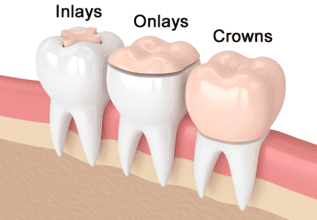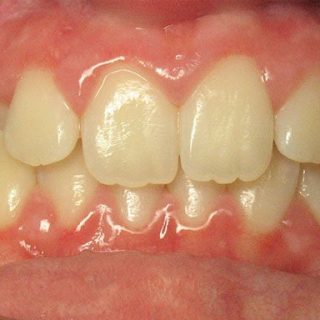According to a study published in the Journal of Conservative Dentistry in 2010, composites have a greater capacity to absorb compressive loading forces and reduce impact forces by 57% more than porcelain. This makes composite inlays and onlays an excellent choice for restorative dentistry, offering enhanced durability. Over the past few decades, these materials have significantly evolved, transforming how dentists approach tooth restoration. Initially, traditional materials like gold and amalgam were the go-to choices for filling cavities. However, advancements in dental technology led to the development of composite resins. Offering improved aesthetics and versatility, composites quickly gained popularity for their ability to blend seamlessly with natural tooth color.
Defining Composite Inlays and Onlays
Composite inlays and onlays, also known as partial crowns, are dental restorations used to repair teeth with moderate decay or damage. Unlike traditional fillings, they are custom-made to fit the cavity precisely and are made from a blend of zirconia, silica, and plastic materials. These restorations offer strength and a natural look while keeping more of the original tooth structure, making them long-lasting and aesthetically pleasing substitutes for crowns and fillings.
- Inlays: When damage is limited to the tooth’s center, inlays are used to fill cavities inside the tooth, usually on the chewing surface.
- Onlays: These are similar but cover a larger area, extending over one or more cusps (the pointed portions of the tooth), usually for larger decay or damage. inlays.
Advantages of Using Inlays & Onlays
- Improved Fracture Resistance: The restorations are fracture-resistant, hence offering long-term durability.
- Improved Wear Resistance: The composite restorative materials have great wear resistance, allowing for long-term use.
- Better Contouring of Proximal Surfaces: The inlays and onlays give accurate fit and contour, maintaining ideal contact with adjacent teeth.
- Enhanced Occlusal Contacts: They improve the alignment and contact of upper and lower teeth, aiding in a more natural bite.
- Increased Tooth Strength: These restorations enhance the overall strength of the treated tooth.
- Natural Appearance: They look typically like the natural teeth, providing a smooth, seamless appearance.
- Ease of Cleaning: They are easy to clean, reducing plaque buildup and maintaining oral hygiene.
- Long-Term Decay Prevention: These restorations help prevent future decay by sealing the tooth effectively.
- Extended Tooth Lifespan: They contribute to a longer lifespan for the treated tooth by preserving and protecting it.
Composite Inlay Onlay Indications
According to a review study published in The Journal of Dental Health Oral Disorders & Therapy in 2015, composite inlays and onlays are indicated for patients who meet the following criteria:
- The patient is seeking a high-quality aesthetic result, as inlays and onlays blend seamlessly with natural teeth.
- The patient practices good oral hygiene, ensuring that the restoration remains effective and durable over time.
- The patient does not have allergies to materials such as amalgam or other components used in fillings.
- The patient has experienced considerable loss of tooth structure due to cavities, fractures, or wear and requires a durable, restorative solution that preserves the tooth’s functionality.
Composite vs Porcelain Inlays and Onlays
Factor | Composite | Porcelain |
Preparation | Requires less tooth structure to be removed | Requires more tooth structure removal |
Ease of repair | Can be easily repaired | May need to be completely replaced. |
Aesthetics | Can be color-matched to natural teeth, offering | Good aesthetic qualities, but may not blend as seamlessly as composite |
| Cost | Less expensive than porcelain. | Higher cost compared to composite |
Bonding | Can be firmly attached to the tooth structure, creating a durable bond. | Requires cementation. |
Resistance to chewing force | Less efficient at withstanding chewing pressure | More efficient at withstanding chewing pressure |
Marginal Adaptation | Better marginal adaptation | Less marginal adaptation |
Comparing Composite Filling & Inlay Onlay Composite
Factor | Composite Fillings | Composite Inlays/Onlays |
Coverage Area | Covers a smaller, localized area of the tooth. | Covers a larger area, preserving more natural tooth structure. |
Aesthetic Quality | Blends with tooth color but may not be as seamless for larger restorations. | Blends more naturally with the tooth and offers better aesthetics. |
Cost | Generally more affordable. | More expensive due to custom fit and multiple appointments. |
| Treatment Time | Completed in a single appointment. | Requires two appointments: one for impressions, the second for placement. |
Composite Inlay, Onlay Procedures
As mentioned previously, inlays and onlays procedure takes 2 separate appointments to complete the following:
The first appointment:
- During the first appointment, the dentist numbs the tooth using local anesthesia.
- After numbing, the dentist removes any affected and decayed areas of the tooth.
- Then once the area is clean, the dentist starts taking an impression of the tooth.
- The dentist places a temporary inlay or onlay, and schedules a second appointment to pace the permanent restorations.
The second appointment:
- The laboratory custom- made composite inlay or onlay is ready to be placed.
- During this second appointment, the dentist removes the temporary restoration and replaces it with the permanent restoration which is bonded with strong adhesives
- Lastly, the dentist examines teeth alignment to make sure the bite feels right and comfortable.
Avoiding Potential Risks: Expert Tips from El-Shenawy Clinics
To ensure the longevity of your composite inlays and onlays, and to maintain optimal oral health, El-Shenawy Clinics recommend the following care practices:
- Commit to Regular Dental Care: Maintain a consistent oral hygiene routine, including daily brushing and flossing, to prevent plaque buildup and ensure the health of your restorations.
- Schedule Regular Dental Check-ups: Regular visits to your dentist are crucial for monitoring the condition of your inlays/onlays and overall oral health.
- Limit Staining Foods and Drinks: To keep your restorations looking their best, avoid consuming foods and beverages that may stain, such as coffee, tea, and red wine.
- Avoid Hard Foods: To prevent unnecessary wear or damage to your inlays and onlays, refrain from chewing on hard foods like ice, nuts, or hard candy.
At El-Shenawy Clinics, we lead the way in dental care and cosmetic dentistry, offering innovative solutions to a wide range of dental issues. Using the latest techniques and technologies in the Middle East, we ensure the highest standards of sterilization and safety for our patients.
Frequently Asked Questions
- Is an onlay a possible alternative to a crown?
Yes, if your case requires only a minor restoration to fix the decayed cusps of a tooth.



















